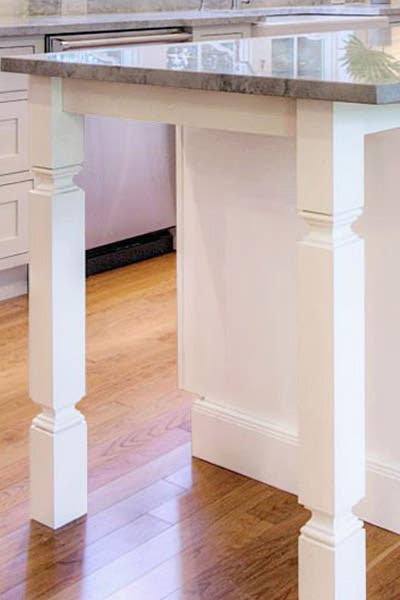Upgrade Your Kitchen's Aesthetic with Costs Legs For Kitchen Island
Upgrade Your Kitchen's Aesthetic with Costs Legs For Kitchen Island
Blog Article
A Guide to Selecting the Perfect Legs For Cooking Area Island for Your Home
Picking the perfect legs for your kitchen island is a nuanced decision that affects both the capability and aesthetic charm of this main space. As you take into consideration these elements, it comes to be evident that the appropriate legs can change not only the look of your kitchen however additionally its use for years to come.

Understanding Kitchen Island Legs
When picking legs for a cooking area island, it's vital to comprehend their functional and aesthetic roles in the general design. The legs function as a crucial support group, making sure security and longevity for the island, which often operates as a work space, dining location, or gathering spot. As a result, the option of product and building strategy need to be durable sufficient to withstand daily use and prospective wear.
Along with their architectural obligations, legs contribute considerably to the island's visual charm. They can enhance the cooking area's style, whether with standard, contemporary, or eclectic layouts. The elevation and percentage of the legs are also vital factors to consider; they should integrate with the island's counter top elevation while making certain comfy seating for those making use of the space.
Furthermore, the leg style can affect the general circulation of the kitchen. Open, ventilated leg styles can produce a sense of agility, while strong, significant legs might share an extra grounded and secure visual - Legs For Kitchen Island. Comprehending these aesthetic and useful facets will certainly guide property owners in making informed choices that complement their kitchen's design and improve its usability
Popular Styles and Materials
The choice of legs for a kitchen island includes a variety of preferred styles and products, each offering special attributes that can boost both functionality and visual appeals. Amongst the most sought-after styles are contemporary, rustic, and typical. Contemporary legs usually include smooth, minimal styles that highlight simpleness and tidy lines, making them suitable for contemporary kitchen areas. Rustic designs, on the other hand, accept natural aspects and frequently display recovered timber or distressed coatings, including warmth and appeal to the space. Traditional legs usually show elaborate information and workmanship, boosting classic kitchen area designs.

Height and Stability Factors To Consider

Security is another essential factor to consider. The legs of the kitchen island must give ample support, ensuring that the structure can withstand daily usage without tottering or changing. Product choice plays a considerable function in stability; metal legs, for example, tend to supply higher toughness contrasted to timber. Additionally, ensuring that the island is safely anchored to the floor or wall surface can improve stability, particularly for bigger islands that might birth significant weight.
Matching Your Kitchen Aesthetic
Choosing the ideal legs for your kitchen island exceeds performance; it likewise plays a considerable function in the total aesthetic of the area. When choosing legs, think about the design style of your kitchen. For a modern look, sleek steel or minimalist designs can produce a tidy, modern-day vibe. On the various other hand, typical or rustic cooking areas typically gain from wood legs with intricate outlining or a distressed finish, enhancing heat and personality.
Color is an additional important aspect. Legs that complement or comparison with your island's surface and surrounding cabinetry can produce aesthetic consistency or striking centerpieces. For circumstances, coupling dark wood legs with a light marble kitchen counter can include deepness and interest. Additionally, consider the finish of the legs; matte, glossy, or textured finishes can significantly affect the overall feel of the cooking area.
Installment and Upkeep Tips
Setting up cooking area island legs requires careful focus to information to guarantee both stability and aesthetic allure. Begin by picking an appropriate place for your island, guaranteeing it is level and has adequate area for motion. Use a stud finder to click to find out more situate wall surface studs if you are connecting the legs to a wall surface or utilizing brackets for added support. Mark the positioning of the legs precisely prior to drilling.
When safeguarding the legs, make use of high-grade screws and, if needed, timber glue for extra toughness. For metal legs, make sure that you are making use of suitable anchors and devices to avoid damages to your floor covering. It is recommended to look for levelness after setup, making modifications as required to avoid tottering.
Maintenance is similarly essential for longevity - Legs For Kitchen Island. Routinely examine the legs for any type of indications of wear or helping to browse around this site loosen, specifically in high-traffic areas. Clean the legs with an appropriate cleaner, staying clear of abrasive materials that may scratch the surface area. For wood legs, take into consideration using a timber conditioner occasionally to maintain their finish. By following these setup and maintenance ideas, you can make sure that your kitchen area island legs continue to be both visually appealing and functional.
Verdict
In verdict, choosing the ideal legs for a cooking area island requires mindful factor to consider of elevation, stability, and aesthetic compatibility. Inevitably, thoughtful leg choice plays a vital function in elevating both the functionality and design of the cooking area area.
When choosing legs for a kitchen island, it's crucial to comprehend their functional and visual roles in the total design. Open, airy leg designs can develop a feeling of lightness, while solid, substantial legs might communicate a more based and secure aesthetic. The legs of the kitchen area island need to supply appropriate support, making sure that the structure can stand up to daily use without moving or this tottering.Installing kitchen island legs needs cautious focus to detail to make sure both security and visual allure.In conclusion, picking the suitable legs for a kitchen island necessitates careful consideration of elevation, security, and aesthetic compatibility.
Report this page